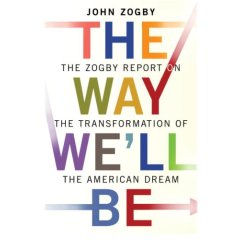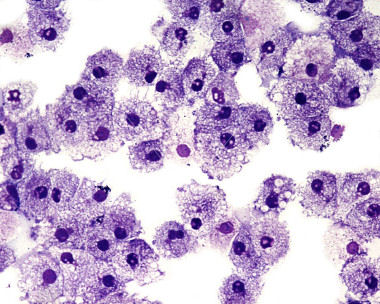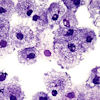Better All the Time #34
It's the Jigsaw Puzzle edition of Better All the Time. Observe how all the different pieces of good news fit togetherto provide a coherent picture...

 | ||
|
Some people will tell you that everything happens for a reason. I don't know that I subscribe to that theory 100%, but I do get the idea sometimes that our understanding of the world is like a partially complete jigsaw puzzle. The pieces don't always come together the way we expect, and when they do start coming together we are often susprised by how well things fit together.
Here are nine very different stories of encouraging developments. The picture is definitely coming together, and I think it's going to be a beauty!
|
Go confidently in the direction of your dreams! Live the life you've imagined. As you simplify your life, the laws of the universe will be simpler.
Henry David Thoreau
Item 1
Potatoes
May Hold Key To Alzheimer's Treatment
A virus that commonly infects potatoes bears a striking resemblance to one of the key proteins implicated in Alzheimer's disease (AD), and researchers have used that to develop antibodies that may slow or prevent the onset of AD.
Studies in mice have demonstrated that vaccinations with the amyloid beta protein (believed to be a major AD contributor) to produce A? antibodies can slow disease progression and improve cognitive function, possibly by promoting the destruction of amyloid plaques.
The Good News:
Do me a favor and just say the following sentence out loud:
A potato virus might hold the cure for Alzheimer's disease.
That's right, a nasty little ring of potato blight, the kind of thing you would peel right off without giving it a second thought, might turn out to be the thing that saves millions of people from the pain and tragedy of dementia and allows them to enjoy a graceful, happy, and productive old age.
Now just stop, wherever you happen to be, and take a good look around. If something as humble and unassuming as a potato virus has the potential to do so much good, what else is sitting out there, right in front of us, ready to change our world in ways we can't even imagine?
Item 2
Star
Trek warp drive is a possibility, say scientists
Two physicists have boldly gone where no reputable scientists should go and devised a new scheme to travel faster than the speed of light.
In the long running television series created by Gene Roddenberry, the warp drive was invented by Zefram Cochrane, who began his epic project in 2053 in Bozeman, Montana.
Now Dr Gerald Cleaver, associate professor of physics at Baylor, and Richard Obousy have come up with a new twist on an existing idea to produce a warp drive that they believe can travel faster than the speed of light, without breaking the laws of physics.
In their scheme, in the Journal of the British Interplanetary Society, a starship could "warp" space so that it shrinks ahead of the vessel and expands behind it.
By pushing the departure point many light years backwards while simultaneously bringing distant stars and other destinations closer, the warp drive effectively transports the starship from place to place at faster-than-light speeds.
All this extraordinary feat requires, says the new study, is for scientists to harness a mysterious and poorly understood cosmic antigravity force, called dark energy.
Dark energy is thought responsible for speeding up the expansion rate of our universe as time moves on, just like it did after the Big Bang, when the universe expanded much faster than the speed of light for a very brief time.
This may come as a surprise since, according to relativity theory, matter cannot move through space faster than the speed of light, which is almost 300,000,000 metres per second. But that theory applies only to unwarped 'flat' space.
And there is no limit on the speed with which space itself can move: the spaceship can sit at rest in a small bubble of space that flows at "superluminal" - faster than light - velocities through normal space because the fabric of space and time itself (scientists refer to spacetime) is stretching.
The Good News
On a recent FastForward Radio, we talked about longshot futures -- future developments that we're rooting for irrespective of the fact that they aren't terribly likely. We ranked longshots on a scale from 1 to 10, with 1's being the more reasonable longshots and 10's being the most outrageous, the developments we have no serious expectation of seeing.
Chatroom participant Matt Duing mentioned faster-then-light travel as a longshot future that he's hoping for, but he had to rank it right around 10. My response was that maybe that number goes down over time. As we learn more, as more pieces of the jigsaw puzzle fall into place, we begin to find ways to do things we never had any reason to expect we could do. If spots on a potato can potentially lead to a cure for Alzheimer's, a universe driven by strings and dark matter and other components we don't yet fully understand might easily yield a workaround to its absolute speed limit.
Time will tell.

Item 3
Oregon Launching First Solar Highway in the US
Oregon is once again taking the lead with renewable energy by installing the country's first highway solar energy project. The project will consist of a 104 kW solar photovoltaic system that covers 8,000 square feet and produces 112,000 kWh each year. That's 28% of the energy needed to power the project's location, the Interstate 5 and Interstate 205 interchange in Tualatin.
Electricity for the interchange will be provided by PGE. The solar panels will come into play by producing electricity during the day, giving the power to the PGE grid, and getting the equivalent amount of power back at night from PGE to power lighting on the highway.
The whole project will literally be Oregon-powered, as companies based in-state will provide materials, design, and installation.
Next year, the Oregon Department of Transportation plans to look at more highway project proposals. Eventually, the department would like to generate 2 million kWh every year with the new projects. They also are looking for proposals that showcase new ways to utilize solar energy, such as solar panels that double as sound walls near highways.
The good news...
Well, this is an excellent start. But if the Oregon DOT is serious about going solar, they need to think bigger than solar panels that double as sound walls. How about turning the highway itself into a massive solar collector? It already is one, right? On hot, sunny days -- and they have their share of those in Oregon -- you have miles and miles and miles of pavement heating up to no constructive purpose. Let's enahnce that blactop with some nano-photovoltaics and hook the highway up to the grid. Then all we have to do is get all the cars running on electricity. Now that will be a solar highway truly worthy of the name.
Also, it's great that the Oregon DOT is soliciting ideas from the public. I wonder if they will award some kind of cool prize to people whose ideas they end up using?

Item 4
Recovery Dawns for Humpbacks and Southern Right Whales
GLAND, Switzerland, August 14, 2008 (ENS) - The humpback whale and other species of large whales are now more secure against extinction than they have been in the recent past, according to the latest cetacean update of the 2008 Red List of Threatened Species released on Tuesday by the International Union for the Conservation of Nature.
"Humpbacks and southern right whales are making a comeback in much of their range mainly because they have been protected from commercial hunting," says cetacean scientist Randall Reeves, who led the IUCN Red List assessment. Reeves chairs the Cetacean Specialist Group of the IUCN Species Survival Commission.
"This is a great conservation success and clearly shows what needs to be done to ensure these ocean giants survive," he said.
The Good News:
There has been some pretty grim speculation lately about the future of the oceans and the creatures who live there, so it is encouraging to see some positive progress where sea life is concerned. We need to learn from the progress we have made with these species of whales and multiple it by many thousands of species of fish, crustaceans, coral, and so on.
If we can, in fact, save the whales, then we have to believe that we can also save the oceans.
Item 5
The Way We'll Be
Book in a nutshell: Americans will face the challenges of the 21st century with creative approaches to consumerism, a cooperative worldview and an inclusive view of spirituality.
That's according to Zogby, president and CEO of Zogby International, a polling company that canvasses about half a million people every year to gauge public opinion on everything from the best laundry detergent to the most promising political candidate.
In The Way We'll Be, Zogby draws on his company's vast network of surveys and polls to try and predict popular trends and attitudes for the near future. Specifically, he seeks to chart general shifts in the American attitude toward a host of issues, from materialism to religion, from environmentalism to the latest take on the American dream.
His results point to a populace much less taken with the traditional signs of status and success. In survey after survey, he finds respondents more apt to be satisfied with less material wealth and more spiritual satisfaction.
Zogby's data also shows that the current generation of 18- to 29-year- olds, what Zogby terms "first globals," are more than willing to make adjustments in the face of dwindling natural resources, threats to the environment and international tensions. His results reveal a young generation tempered by the immediacy and inclusiveness of the Internet, one that's more likely to hold broad and inclusive spiritual views in lieu of rigid definitions of religion and one that's more willing to cooperate on the international stage to find solutions to pressing problems.
The good news:
Zogby spends all his time collecting and cataloging people's views on a wide variety of issues. When he puts all this information together, he sees things heading in a good direction. Who are we to argue?.

Item 6
Immune paradox could help treat Aids
Scientists have found that a drug that traps white blood cells that fight disease can, paradoxically, lead to the clearance of a chronic infection by a virus linked with one form of meningitis.
Their findings, published in the journal Nature, suggest a new strategy for fighting chronic viral infections that could apply to the treatment of important diseases such as hepatitis C and B, and also HIV/AIDS.
The work, reported today in the journal Nature, comes as a surprise because disease-fighting white blood cells vanish from the blood usually signals a weakened immune system.
But preventing white blood cells' circulation by trapping them in the lymph nodes can help mice get rid of a chronic viral infection, researchers at Yerkes National Primate Research and Emory Vaccine Centres have found.
Dr Altman says he and his co-workers are planning to test FTY720's effects with other viruses. As for when tests would begin, Dr Altman said "We try to be cautious and not excite too much premature enthusiasm among people suffering from diseases such as hepatitis C and HIV/AIDS."
The good news:
This one isn't as dramatic as the p[otato virus, but it's even more shocking, when you think about it. White blood cells are usually what we think of us our best line of defense against disease. Trapping them, sequestering them, and / or shutting them down doesn't seem like a smart approach when dealing with killers like hepatitis C or HIV.
And yet...that may prove to be the approach that works. It's like that one jigsaw puzzle piece that you look at and never even pick up becuase obviously that one won't fit. But sometimes it does.

Top
Item 7
Magical Anti-Obesity Pill With '2 In 1' Effects
Want to shed those extra pounds but are worried what if they pile up again after dieting? Don't worry as a new study suggests that taking a pill, a dietary supplement called 'alpha-lipoic acid' stops the body to pile up pounds back again and also slows aging.
The British researchers from University of Liverpool, Britain conducted the study on 102 rats in a laboratory setting and looked at the effects of the dietary supplements on rats. A group of 75 rats were given 'normal' diet while another group of 75 rats were fed 'low-calorie' diets.
They found that the rats which were given the supplement were able to shed off weight even after they went off their calorie-restricted diets.
The team of researchers, led by Malcolm Goyns, revealed that alpha-lipoic acid can "lock in" the benefits of dieting, allowing people on diet to get back to normal eating habits without putting on weight.
Malcolm Goyns, director of Immorgene Concepts, a scientific research company, in Stockton-on-Tees, near Middlesbrough, said, 'It seems that alphalipoic-acid fools the body into behaving as if it was still on whatever diet it was following before the supplement was added."
The good news:
As we noted here, this one sounmds a little too good to be true. But if Alpha lipoic acide delivers even some of the benefits touted, it might prove tremendously helpful for those who have lost weight and yet find their weight creeping back up over time. Here's hoping.

Sweden Rolling Out 183 MPH High-Speed Green Train
Maybe you've heard about the proposed high-speed train in California. Well, Sweden is beating the West Coast to the punch with their Green Train.
The Green Train, or Gröna Tåget, will cut energy use on rail lines by 30 percent through lowered operational costs and journey times. Top speeds reached 183 MPH on a test run. Best of all, the Green Train can operate on the current rail infrastructure. That means there's no need to lay down new tracks. Energy saving measures on the train include a permanent magnet motor to increase propulsion chain efficiency and a system that saves up to 15 percent of traction energy by assisting drivers with speed and traction force information. While the Green Train is significantly slower than California's proposed high-speed rail (and the same speed as the French high-speed train), it has set a Swedish speed record. Additionally, it is already in the testing stages, while the California rail won't be ready for at least 20 years. Research on the Green Train will conclude in 2010 or 2011, so it shouldn't be too long before the system is operational.
The Good News:
A fast-moving train with little or no environmental impact sounds pretty good to us. But maybe they want to take it up a notch and make it solar powered?

Nanoantennas envisioned as possible replacement for solar cells
Imagine the possibilities of harvesting waste heat and converting it into electricity. Computer processors could be the source of power for their own cooling devices and solar cells could become dramatically more efficient by leveraging energy that is not being used today. If everything goes right, nanoantennas could even replace solar cells one day, researchers believe.
Scientists from the U.S. Department of Energy's Idaho National Laboratory believe that plastic sheets containing billions of nanoantennas that collect heat energy generated by the sun and other sources could dramatically improve the use of a type of energy we are all aware of, but have no use for so far – heat. According to research results that will be presented on August 13 at the American Society of Mechanical Engineers 2008 2nd International Conference on Energy, the sheets could one day be manufactured as lightweight "skins" that power everything from hybrid cars to iPods with higher efficiency than traditional solar cells.
The Good News:
Hey, here's another great idea for what we might do with that solar highway! See how all this stuff fits together!

Better All The Time was compiled by Phil Bowermaster. Live to see it!














Comments
Australia could use the energy from infrared to desalinate water and pump it to the outback, enabling cultivation and the growth of cities.
Posted by: David Govett | August 21, 2008 12:00 PM
I love this sort of optimistic set of developments.
The solar highway is perfect - think of the massive amount of land consumed by roads. If those surfaces could also absorb power..... fantasic!!
Posted by: GK | August 21, 2008 07:30 PM